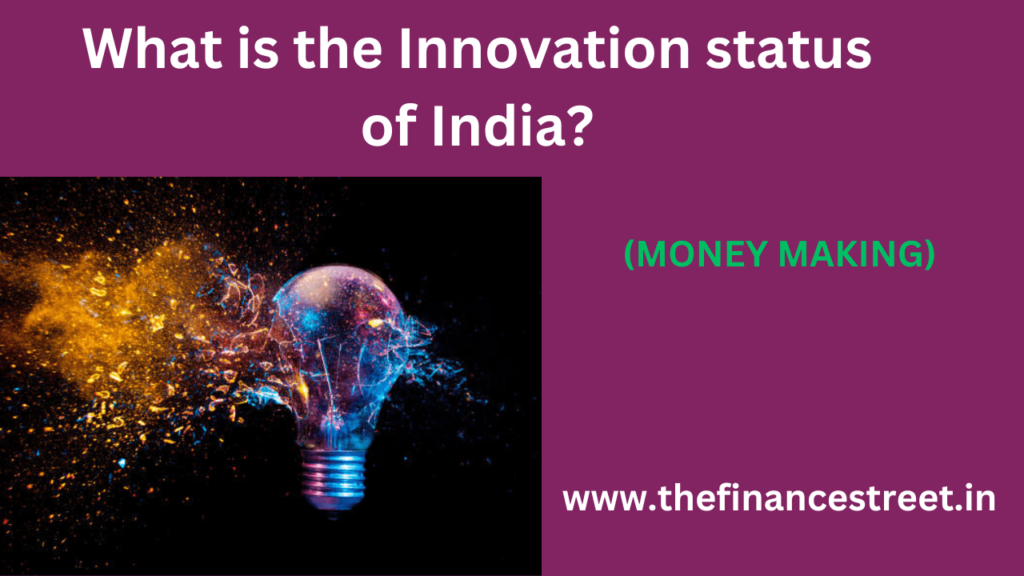Table of Contents
ToggleIntroduction-
India’s innovation landscape is a dynamic tapestry woven with the threads of creativity, entrepreneurship, and technological prowess. With a rich history of scientific discovery and cultural innovation, India stands at the cusp of a transformative era, poised to shape the future of innovation on the global stage. This introduction sets the stage for an exploration of India’s innovation status, delving into the key drivers, challenges, and opportunities that define its innovation ecosystem.
In recent years, India has emerged as a hotbed of innovation, propelled by a burgeoning startup culture, a skilled workforce, and a conducive policy environment. From breakthroughs in technology and healthcare to advancements in sustainable development and social entrepreneurship, Indian innovators are leaving an indelible mark on the world stage. Against the backdrop of rapid technological advancements and evolving market dynamics, India’s innovation status holds immense promise and potential to drive inclusive growth, foster economic prosperity, and address pressing societal challenges.
However, India’s innovation journey is not without its hurdles. Challenges such as infrastructure gaps, regulatory complexities, and access to funding pose significant barriers to realizing the full potential of India’s innovation ecosystem. Moreover, bridging the gap between urban and rural innovation, promoting diversity and inclusion, and nurturing a culture of risk-taking and experimentation are critical imperatives for fostering a vibrant and resilient innovation ecosystem in India. As India navigates the complexities of the 21st-century global economy, unlocking the full potential of its innovation prowess will be pivotal in shaping a brighter and more prosperous future for generations to come.
What is the innovation status of India?
As India has been making significant strides in innovation across various sectors, positioning itself as a global player in technology and entrepreneurship. Several factors contribute to India’s innovation status:
- Tech Hub: India has emerged as a leading destination for technology and innovation, particularly in cities like Bangalore, Hyderabad, and Pune. These cities host a vibrant ecosystem of tech startups, research institutions, and multinational companies, fostering innovation in areas such as software development, artificial intelligence, and biotechnology.
- Startup Culture: India has witnessed a boom in startup activity, with a growing number of entrepreneurs launching innovative ventures across diverse sectors. Initiatives like Startup India and various incubators and accelerators have fueled this entrepreneurial ecosystem, encouraging innovation and fostering a culture of risk-taking and experimentation.
- Government Initiatives: The Indian government has launched several initiatives to promote innovation and entrepreneurship, including the Atal Innovation Mission (AIM), Make in India, and Digital India. These programs aim to support startups, encourage research and development, and facilitate collaboration between academia, industry, and government.
- Research and Development: India boasts a strong research and development (R&D) infrastructure, with premier institutions like the Indian Institutes of Technology (IITs), Indian Institutes of Management (IIMs), and Indian Institutes of Science Education and Research (IISERs) driving innovation in various fields. Public and private investment in R&D has been steadily increasing, contributing to India’s innovation ecosystem.
- Global Recognition: Indian innovators and startups have gained international recognition for their contributions to technology and business innovation. Indian companies have made significant strides in areas such as e-commerce, fintech, healthcare, and renewable energy, garnering attention from investors and stakeholders worldwide.
While India has made significant progress in fostering innovation, challenges remain, including infrastructure gaps, regulatory hurdles, and access to funding. Addressing these challenges will be crucial for India to sustain its momentum and further strengthen its position as a global hub for innovation in the years to come.
What is the innovative status of India compare to Global market?
India’s innovative status, when compared to the global market, reflects a mix of strengths and challenges. While India has made significant strides in fostering innovation and entrepreneurship, particularly in the technology sector, it still faces several barriers that affect its competitiveness on the global stage.
Strengths:
- Tech Hub: India has established itself as a prominent tech hub, with cities like Bangalore, Hyderabad, and Pune emerging as centers of innovation and entrepreneurship. The country’s vibrant startup ecosystem, coupled with a large pool of skilled IT professionals, has propelled India to the forefront of technology innovation.
- Startup Culture: India boasts a thriving startup culture, characterized by a growing number of innovative ventures across various sectors. The government’s initiatives such as Startup India and favorable policies for startups have fostered an environment conducive to entrepreneurship and innovation.
- Global Recognition: Indian companies and innovators have gained international recognition for their contributions to technology and business innovation. Indian startups have disrupted traditional industries and gained market share globally, particularly in sectors like e-commerce, fintech, and software development.
Challenges:
- Infrastructure: India’s infrastructure challenges, including inadequate physical infrastructure and digital connectivity, pose barriers to innovation and economic growth. Limited access to reliable electricity, transportation networks, and high-speed internet can hinder the scalability of innovative ventures.
- Regulatory Hurdles: Regulatory complexities and bureaucratic red tape can impede innovation and entrepreneurship in India. Cumbersome processes for business registration, taxation, and compliance often deter startups and hinder their ability to innovate and grow.
- Access to Funding: While India has seen a surge in venture capital investment in recent years, access to funding remains a challenge for many startups, particularly those in early-stage and non-tech sectors. Limited availability of risk capital and a conservative approach by traditional financial institutions can constrain innovation and growth.
- Skill Gap: Despite having a large pool of technical talent, India faces a skill gap in emerging technologies such as artificial intelligence, data science, and cybersecurity. Addressing this gap through education and training programs is essential to sustain India’s competitiveness in the global innovation landscape.
In summary, while India has made significant strides in fostering innovation and entrepreneurship, it still faces challenges in infrastructure, regulation, funding, and skills development. Overcoming these challenges will be crucial for India to enhance its innovative status and compete effectively in the global market.
What are the important elements of successful Innovation?
Successful innovation relies on several important elements that contribute to its effectiveness and impact. These elements include:
- Creativity: Creativity is the foundation of innovation. It involves generating novel ideas, concepts, and solutions to address existing challenges or capitalize on new opportunities. Encouraging creativity within an organization fosters a culture of innovation and fuels the development of breakthrough products, services, or processes.
- Market Understanding: Successful innovation is grounded in a deep understanding of market dynamics, customer needs, and industry trends. By conducting thorough market research and analysis, innovators can identify unmet needs, anticipate future demands, and tailor their innovations to meet market requirements effectively.
- Collaboration and Diversity: Collaboration and diversity play crucial roles in driving successful innovation. By bringing together individuals from diverse backgrounds, expertise, and perspectives, organizations can foster cross-pollination of ideas, facilitate brainstorming sessions, and encourage the exchange of innovative insights and approaches.
- Risk-Taking and Experimentation: Innovation inherently involves risk-taking and experimentation. Successful innovators are willing to challenge the status quo, explore unconventional ideas, and experiment with new approaches, technologies, and business models. Embracing failure as a learning opportunity and being resilient in the face of setbacks are essential aspects of successful innovation.
- Adaptability and Agility: In today’s rapidly changing business environment, successful innovation requires adaptability and agility. Innovators must be responsive to evolving market conditions, customer feedback, and technological advancements. Adopting agile methodologies and iterative approaches allows organizations to quickly pivot, refine, and iterate their innovations based on real-world feedback and data.
- Resource Allocation: Adequate resource allocation is critical for successful innovation. Organizations must allocate sufficient financial, human, and technological resources to support the innovation process from ideation to implementation. Effective resource management ensures that innovation initiatives have the necessary support and infrastructure to thrive and deliver tangible outcomes.
- Leadership and Vision: Strong leadership and vision are essential for driving successful innovation within an organization. Visionary leaders inspire and empower teams to pursue bold ideas, challenge conventional thinking, and overcome obstacles on the path to innovation. They provide strategic direction, create a supportive environment for innovation, and champion a culture of continuous improvement and learning.
By embracing these important elements of successful innovation, organizations can cultivate a dynamic and innovative culture, drive sustainable growth, and maintain a competitive edge in today’s rapidly evolving business landscape.
What is the role of Education and Culture for Innovation skills?
Education and culture play pivotal roles in nurturing and developing innovation skills among individuals and within organizations. Here’s a breakdown of their respective roles:
Education:
- Skill Development: Education provides individuals with the foundational knowledge, skills, and competencies needed to innovate effectively. By imparting technical expertise, critical thinking abilities, problem-solving skills, and creativity, education equips individuals with the tools necessary to identify opportunities, generate ideas, and execute innovative solutions.
- Exposure to Diverse Perspectives: Education exposes individuals to diverse perspectives, disciplines, and fields of study, fostering interdisciplinary thinking and cross-pollination of ideas. Exposure to a broad range of subjects encourages individuals to connect disparate concepts, draw inspiration from different domains, and explore innovative approaches to complex challenges.
- Research and Innovation Ecosystems: Educational institutions serve as hubs of research and innovation, providing opportunities for students, faculty, and researchers to collaborate on cutting-edge projects, conduct experiments, and explore new frontiers of knowledge. By fostering collaborative research environments and supporting innovation initiatives, education contributes to the advancement of science, technology, and innovation.
Culture:
- Supportive Environment: A culture that values and supports innovation creates an environment where individuals feel empowered to take risks, experiment with new ideas, and challenge the status quo. Cultivating a culture of innovation involves encouraging open communication, embracing diversity of thought, and celebrating creativity and initiative.
- Continuous Learning and Improvement: A culture of innovation promotes continuous learning and improvement at all levels of an organization. By fostering a growth mindset and encouraging employees to seek out new knowledge, acquire new skills, and pursue professional development opportunities, organizations can create a culture of lifelong learning that fuels innovation and adaptation.
- Risk-Taking and Failure Tolerance: In an innovative culture, risk-taking is encouraged, and failure is viewed as a learning opportunity rather than a setback. Cultivating a tolerance for failure allows individuals and organizations to experiment with new ideas, learn from mistakes, and iterate on their innovations more effectively.
- Collaboration and Knowledge Sharing: Collaboration and knowledge sharing are essential aspects of an innovative culture. By fostering a collaborative environment where ideas can be freely shared, refined, and developed, organizations can harness the collective intelligence of their teams and drive innovation through cross-functional collaboration and interdisciplinary teamwork.
In summary, education and culture are both integral to the development of innovation skills and capabilities. Education provides individuals with the knowledge, skills, and competencies needed to innovate, while culture shapes the attitudes, behaviors, and norms that define how innovation is encouraged, supported, and rewarded within organizations and societies. By investing in education and cultivating a culture of innovation, individuals and organizations can unlock their full potential and drive meaningful progress and change.
Critical Analysis of Innovation Status of India-
A critical analysis of India’s innovation status reveals a complex landscape marked by significant progress and persistent challenges. While India has made commendable strides in fostering innovation across various sectors, there are several key areas that warrant critical examination:
Strengths:
- Thriving Startup Ecosystem: India’s startup ecosystem has witnessed exponential growth in recent years, with a surge in the number of innovative ventures across sectors such as technology, e-commerce, healthcare, and fintech. Initiatives like Startup India and the proliferation of incubators and accelerators have contributed to this vibrant ecosystem, fostering entrepreneurship and innovation.
- Technical Talent Pool: India boasts a vast pool of technical talent, with a robust network of engineering and management institutions producing skilled professionals in fields such as software development, data science, and engineering. This abundance of talent serves as a key asset for driving innovation and technological advancement in the country.
- Policy Support: The Indian government has introduced several policy initiatives aimed at promoting innovation and entrepreneurship, including tax incentives, regulatory reforms, and funding support for startups and research institutions. These policy interventions have created an enabling environment for innovation and contributed to India’s emergence as a global innovation hub.
Challenges:
- Infrastructure Deficiencies: India continues to grapple with infrastructure deficiencies, including inadequate physical and digital infrastructure. Poor connectivity, unreliable power supply, and limited access to high-speed internet pose significant barriers to innovation and economic growth, particularly in rural and semi-urban areas.
- Regulatory Complexity: Regulatory complexities and bureaucratic hurdles remain major challenges for innovators and entrepreneurs in India. Cumbersome processes for business registration, compliance, and licensing can deter startups and hinder their ability to scale and innovate effectively.
- Access to Funding: While access to funding for startups has improved in recent years, access to early-stage and risk capital remains a challenge for many entrepreneurs, particularly those outside major urban centers. Limited availability of venture capital, along with risk-averse attitudes among traditional financial institutions, hampers innovation and entrepreneurship in India.
- Education System: Despite producing a large number of technical graduates, India’s education system often falls short in nurturing critical thinking, creativity, and problem-solving skills essential for innovation. Rote learning and a focus on academic qualifications over practical skills hinder the development of an innovation-driven workforce.
In summary, while India has made significant progress in fostering innovation and entrepreneurship, there are still critical challenges that need to be addressed to unlock the full potential of its innovation ecosystem. Addressing infrastructure deficiencies, streamlining regulatory processes, enhancing access to funding, and reforming the education system are essential steps toward creating a more conducive environment for innovation and driving sustainable economic growth in India.
Conclusion –
In conclusion, India’s innovation status represents a compelling narrative of promise, progress, and potential. As a nation with a rich tapestry of culture, creativity, and intellect, India stands poised to harness the power of innovation as a catalyst for transformative change. Despite facing challenges such as infrastructure gaps, regulatory complexities, and access to funding, India’s innovation ecosystem continues to evolve and thrive, driven by the collective ingenuity and resilience of its people.
Looking ahead, India’s innovation journey holds immense promise for driving inclusive growth, fostering economic prosperity, and addressing complex societal challenges. By embracing a culture of collaboration, fostering diversity and inclusion, and investing in education, research, and infrastructure, India can unlock new frontiers of innovation and position itself as a global leader in the knowledge economy.
As India charts its course towards a future defined by innovation and progress, the collective efforts of government, industry, academia, and civil society will be instrumental in realizing this vision. By harnessing the power of innovation to create positive impact and empower communities across the country, India can chart a path towards a more prosperous, sustainable, and inclusive future for all.



